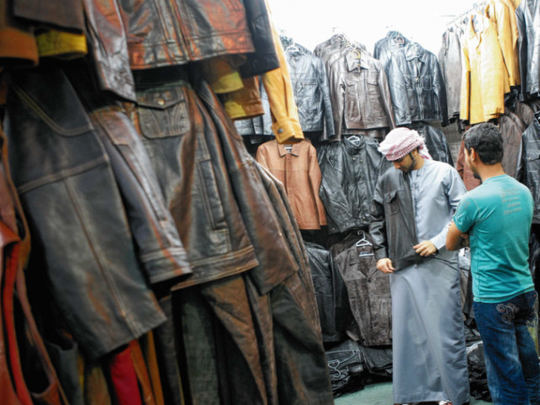
Asim Shah is busy haggling in Arabic with a customer at his Classic Boutiques stall located in the Pakistan pavilion at Dubai’s Global Village. “Ma betawefi,” he says, explaining to the client that the price she wants to pay for eight yards of dress material does not even cover his cost. After some back and forth, the sale is complete and the shopper has bought five sets of nicely printed lawn, a fine linen or cotton fabric, that Pakistan is famous for.
Importance of exhibitions
According to statistical research website Trading Economies, which cites the Pakistan Bureau of Statistics, Pakistani exports increased to 197,202 million Pakistani rupees (Dh7.4 billion) in January this year from 191,408 million rupees in December 2012. The US is its biggest trading partner, followed by the UAE, which is the destination for 10 per cent of total exports.
An erratic power supply that leads to increased production costs and a political situation that keeps many foreign buyers away mean that exhibitions are crucial for trade. And rather than merely showcasing goods from Pakistan, exhibitors tailor their wares according to retail or wholesale demand in the host country.
“More than half of our sales come from exhibitions. But Lahore’s exhibition market has dwindled over the past ten years or so due to the political situation, so we focus on exhibitions in other countries,” says Shah, who has been working with Classic Boutiques for three years.
He is at home in various exhibition destinations around the world — the GCC countries, India, Sri Lanka, Bangladesh, Nepal, Madagascar, Kenya and Mauritius. Tunics do well in Madagascar; Gambians prefer yards and yards of material to make one dress; in the UAE, matched sets of material are used to make jalabiyas with accompanying scarves. In India, these are salwar kameez sets.
At Global Village, which remains open until March 31, textiles dominate the Pakistan pavilion. As the country’s largest industrial sector, textiles generate Pakistan’s highest export earnings at about 58 per cent, provide the bulk of employment at 39 per cent and contribute 8.5 per cent to the country’s GDP, according to the Ministry of Textile Industry.
Umar Badshah, who sells Pathan-style hand-embroidered outfits for women, is another face of this industry. His customers in Dubai include retail buyers and small business persons who buy hand-embroidered patches to sew on garments that they fashion.
All exhibitors have dealt with the fallout of power cuts by the government since December last year, following a sharp rise in demand from household users, as well as the annual closure of water reservoirs. And while the supply was restored in early March, much damage has been done.
“Because of electricity problems in Pakistan our production costs have gone up. If we use generators instead of the power supply, the costs are much higher. What we used to sell for 2,500 rupees now goes for about 4,000-5,000 rupees. This means that if earlier a customer was buying two outfits for a function, now they will only buy one,” says Badshah, who runs the boutique with his cousin, Akbar Ali.
Leather that weathers
Leather is another item that sees a throng of visitors at the pavilion. Mohammed Razak Khokhar, a leather products dealer, has been a Global Village regular for the past 13 years. His motorcycle accessories — gloves, jackets and hats — are hot sellers in Dubai.
But he is also focused on bulk buyers for whom he carries other stock. “Our buyers do not want to travel to Pakistan. They would rather come to Dubai. I have met bulk buyers from the GCC countries, South Africa, Russia and China. People take stuff back to the UK and Central Russia as well,” he says.
Khokhar chases the winter the world over, travelling to Pretoria in South Africa in April when winter starts there, and Montreal in Canada just before the start of Global Village in early October. “We now have a warehouse in Ajman where we are able to make any alterations if our customers want,” he says.
International buyers are increasingly lured by cheaper products from nearby countries. “There is constant load shedding so our production is affected. In some places, depending on the availability of power we work at night. Our export market is affected because cost of production has gone up. We are not getting the prices that we want because the product costs us more than it did earlier. If we sell something for $2.5 (Dh 9.18) when it costs $2 in nearby countries, who will buy from us?” says Khokhar.
Exhibitors use the Global Village set-up for more than five months in Dubai to renew trade relationships and to network. They say visas, which are not always easy to come by, are organised by professionals who guarantee that their investments will be returned in case they cannot be processed.
Everyone has some experiences to narrate — some travelled under police protection in times of strife, another person had to answer many questions from the customs authority when a tiny piece of wire found its way into his luggage. Even so, they travel the world with goodwill and commercial benefits as passports for cross-border bureaucracy, peppering the trade with customary charm and warmth. These travelling entrepreneurs also act as informal ambassadors for their country. Umar Badshah and Akbar Ali, for instance, are from Saidhu Sharif in Swat Valley, a proud home to teenage education rights activist Malala Yusufzai, who was shot and wounded by Taliban insurgents last October.
Badshah says: “Things are not as bad as depicted in the media. Girls can go out. In the morning, if you land in Swat you will see scores of girls making their way to schools. And if you do visit us, you will never want to leave. Our people were known for their courage and for their hospitality. They are brave, warm people.”




